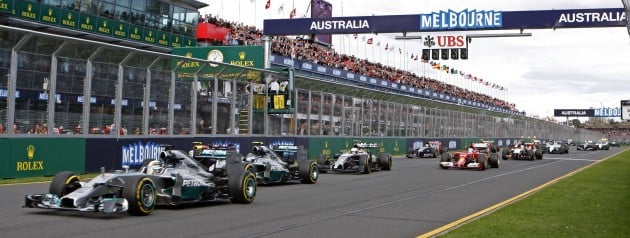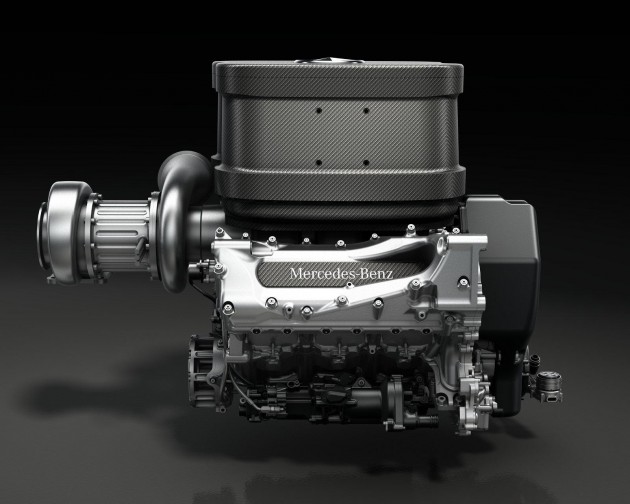There has been a lot of conjecture on social media about the 2014 Formula 1 cars after the first race of the season in Melbourne last weekend. People have been lamenting the loss of the 2.4 V8s that ran for the past eight years, saying that the new “power units” sound terrible and that the racing is weird and it doesn’t feel like Formula 1 anymore.
Earlier this week, the organisers for the Australian Grand Prix claimed that they planning to sue the Formula 1 management, claiming that the quieter engines reduced the spectacle of the sport, breaching their contract. Even Bernie Ecclestone himself has been, ahem, vocal about the engines’ lack of volume.
What utter cobblers.
The whole point of Formula 1 is that it’s supposed to be the pinnacle of technology. For years, it’s been behind the curve, banning electronic this and variable valve that. But now the innovating spirit of the sport is back, and people are complaining that the sound of the engines are not the same as it used to be?
If everyone back in the day was so worried about engine sounds, we would’ve gone backwards. We would’ve never gone from 2.5-litre engines to 1.5 back in the 1960s and pushed engine technology further to try and claw some of the power back. We would’ve never gone through the first turbo era in the ’80s. All that incredible racing that spawned from those periods, gone. So it would be a shame that all this promising new technology gets nipped in the bud because people think screaming gas-guzzling engines are the way forward instead.
And what excellent pieces of technology these new power units are. At the heart of each unit sits a 1.6 turbo V6 producing around 600 hp – that’s pushing 400 hp per litre from the engine alone. Yes, it’s turbocharged, but bear in mind that it’s the first year these guys are using this radically different technology, and the power levels are only set to rise. This engine makes Audi’s record-breaking 420 hp 2.0 turbo four in that TT Quattro Sport concept looks like child’s play.
Added to that, there are two electric motor units. One of them (Motor Generator Unit – Kinetic, MGU-K) works just like the KERS in previous seasons, capturing kinetic energy normally lost through braking and storing it in the battery to be used later. As before, this energy can be used to boost the car’s performance, but instead of the piffling 80 hp KERS produced over a span of about six seconds, MGU-K delivers double that power over five times the duration.
The second, more intriguing motor is the MGU-H, which is connected to the turbocharger and derives its energy from the heat (that’s the H there) of the exhaust gasses passing through. The electricity gained can either be also stored in the battery, used to slow the turbos off throttle (negating the need for a wastegate) or – this is the bit that really does my head in – spool the turbos up when there’s not enough exhaust gas to power it, practically eliminating turbo lag.
Did you get that, guys? These…wizards have found a way to build a crazily-boosted 1.6-litre engine that has literally zero turbo lag. None, zip, nada. Now that’s progress.
And who said Formula 1 was out of touch with the production car industry? True, last year’s 2.4 V8 had as much to do with your mother’s Camry as wheels did to snowboards. But now that the engines have been downsized and turbocharged and make almost as much power while using 30% less fuel, the sport is starting look a lot more relevant to the common man.
Besides, if you guys really were concerned with engine sounds you really should go back to 2005 to hear the last of the truly great sounding F1 engines – the 3.0 litre V10. Those things, with that tuneful yowl as they screamed past 19,000 rpm, that was a proper symphony.
The high-pitch wail of the flat-plane V8 sounds flat in comparison, like a superbike that’s had its rev limiter removed. At least the V6s, while nowhere near as high-pitched, has a much more interesting gravelly tone, with a great yelp on the overrun. They sounded like that in the ’80s, and nobody gave two hoots back then…
As for the people who complained about how the cars weren’t as loud as they used to be, I’m sorry, but have you ever been at a race with ear plugs? They were horrible – it meant you couldn’t hear the engine properly anyway, they clogged up your ears and made you feel miserable, they made you look like an idiot when your companion yelled at you and you just sat there as if nothing happened and at the end of the day you had to fish them out with a chopstick and one of them would usually end up stuck halfway up your ear canal anyway.
I look at those people on the stands at Melbourne and think of how nice it must be to get an unadulterated earful of engine noise while still being able to talk to other people normally, to be able to hear other things like wheelspin and lockups, to no longer have the feeling of your brain being sucked out by two little pieces of foam in your ears.
As for the racing, was I watching the same race some of you guys were? Three relatively young racers stood on the podium, all of them getting an upper hand over their more esteemed teammates simply because they managed the new technology better. There were crashes, there were some brilliant battles and there were real surprises.
And there was real racing. There’s actual skill involved in deciding when to save fuel and when to put the hammer down, making races properly riveting. Not the fake unpredictability of the orchestrated catastrophic loss of grip on the old Pirellis where drivers had no choice but to accept their fate as their cars became more and more undrivable.
Yes, there were big gaps in performance between the teams – as with any other sport with such drastic change in regulations, some people cope with it better than others. But as more is learned about the new cars and the new technology, the racing will definitely get closer.
And of course, who doesn’t like to see a winner of a Grand Prix in recent years that wasn’t Sebastian Vettel?
Looking to sell your car? Sell it with Carro.






AI-generated Summary ✨
Comments express frustration over the quieter engine sounds and slower speeds of the 2014 F1 cars compared to previous eras, such as the V8 and turbocharged 80s. Many feel the lack of noise diminishes the excitement and spectacle of live races, with some comparing it to a library rather than a concert. Others defend the technologicalprogress, emphasizing F1's shift towards greener, more efficient power units, and highlight that the sport's appeal also lies in driver skill and team strategy. Several commenters believe that the sport's future depends on balancing advanced technology with engaging spectacle, including reviving the traditional roar of engines, while some suggest simplifying rules to focus on driver competition. Overall, sentiments are mixed, with disappointment over noise and speed but recognition of technological advancement.